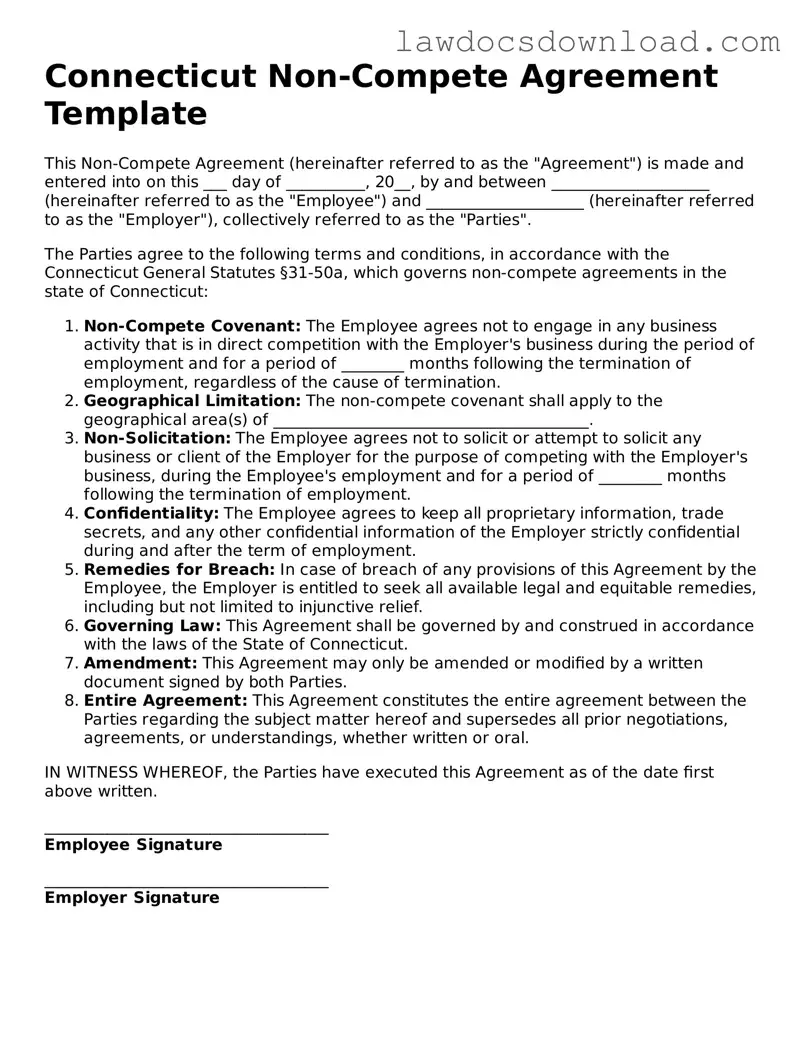A Connecticut Non-compete Agreement bears similarity to an Employment Contract, which outlines the terms of employment, roles, and responsibilities between an employer and employee. Both documents detail the obligations of the parties involved but differ in scope; while the Non-compete Agreement specifically restricts an employee's ability to work in competing businesses after leaving the company, an Employment Contract covers a broader range of employment terms, including but not limited to non-compete clauses.
A Non-disclosure Agreement (NDA) is another document closely related to the Connecticut Non-compete Agreement. Both aim to protect the company’s interests - the NDA by restricting the sharing of confidential information and the Non-compete Agreement by preventing competition. Each document serves to safeguard the business, though they focus on different aspects of protection (information vs. competition).
The Non-solicitation Agreement, much like the Non-compete Agreement, is designed to protect a business's interests post-employment, but with a focus on preventing former employees from poaching clients or recruiting former colleagues. This similarity lies in their shared goal to prevent actions that could harm the business after an employee leaves, differing primarily in the scope of the restricted activities.
Independent Contractor Agreements also share common ground with Connecticut Non-compete Agreements, as they can include clauses that restrict contractors from competing with the business during or after the contractual period. While the Non-compete Agreement typically applies to employees, Independent Contractor Agreements apply to freelancers or contractors, highlighting the versatility of non-compete clauses across different types of working relationships.
The Confidentiality Agreement, focused on the nondisclosure of proprietary information, is similar to the Non-compete Agreement in its protection of the company’s sensitive information indirectly. By preventing direct competition, Non-compete Agreements also help in safeguarding trade secrets and proprietary information, just from a different angle than Confidentiality Agreements.
Business Sale Agreements can include non-compete clauses that limit the seller’s ability to start a similar business, drawing a parallel to the Connecticut Non-compete Agreement’s objective of protecting business interests. This similarity underscores the importance of non-compete clauses in securing a business's competitive advantage, not just in employment but also in commercial transactions.
Partnership Agreements can embrace provisions akin to non-compete agreements to restrict partners from engaging in competing ventures, underscoring the flexible application of non-compete principles. These similarities highlight the effort to preserve business integrity and collaborative interests within a partnership, akin to the employer-employee relationship addressed by Non-compete Agreements.
Lastly, Severance Agreements, which outline the terms under which an employee departs the company, often include non-compete clauses. This similarity shows the broad utility of non-compete clauses in various agreements concerning the end of employment or business relationships, aiming to protect the company's standing and competitive edge in the marketplace.
